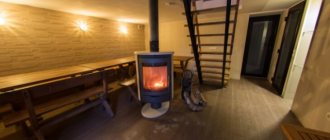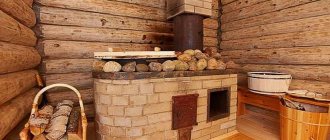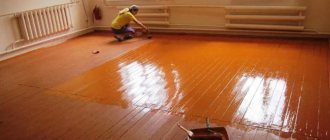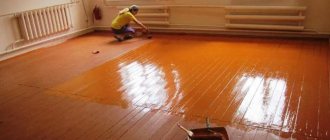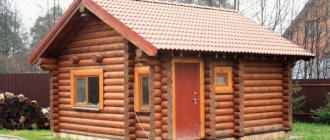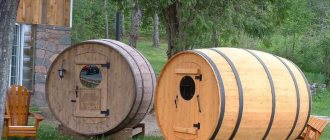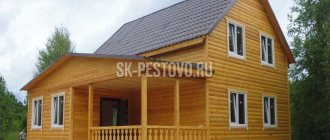According to the requirements of SNiP and SP, a bathhouse on an individual housing construction or SNT site must be located at a certain distance both from the fence and from residential and outbuildings, water supply sources and other objects.
The location of the bathhouse on the site must be determined in advance
If the bathhouse is located too close to a house, well, neighbor’s property or fence, its construction may be considered illegal and the owner may be required to remove the building. To avoid problems, you should take into account the requirements of building and fire safety standards at the stage of creating a project, especially if you develop it yourself.
Pros and cons of a bathhouse in the house
Of course, a good bathhouse is a luxury that you want to have with you.
Therefore, many are considering options for country houses with a built-in bathhouse. The advantages of having a bathhouse in the house can be divided into the following points:
- Availability. Despite the fact that a free-standing bathhouse is usually located on a site not so far from the house, a built-in one still has an advantage: it is more comfortable to heat and prepare for use. You won’t have to run around and check the firebox many times, control the temperature – everything will be at your fingertips.
- Minimizing colds. If there are children in the family, then you can’t think of a more ideal option with a bathhouse in the house. Hardening in the fresh air, swimming in the snow, constant drafts - this is suitable for avid bath attendants with extensive life experience than for women with children.
- Economical. It will take much more money to build a free-standing sauna than to build a small indoor sauna. What does it cost to install communications and supply hot water? Approximate budget savings can reach 50% if the layout of the basement floor is drawn up correctly and does not have “blind” places.
- Comfort of use. Usually, mini-saunas with more efficient heating and for short-term use are installed in the house. Such a sauna is easy to heat, however, the resulting heat does not last more than 6-8 hours.
Small saunas in the house are a compromise in the absence of funds and sufficient territory to build a separate full-fledged room. Source el.decorexpro.com
The following list includes the significant disadvantages:
Presence of dampness. As a rule, dampness appears when the ventilation system is not properly designed. In addition to the forced ventilation shaft, natural passages must be built into the wall openings, allowing warm air to freely leave the room.
- Presence of noise in the house. Despite the fact that the bathhouse in the basement has good sound insulation, some sounds during its operation will still be heard, especially if a large company gathers.
- Autonomy from home. Single men go to the bathhouse to take a steam bath, married men go to the bathhouse to take a break from family life. For people who love privacy and silence, a bathhouse in the house will not give the same feeling of relaxation as, for example, relaxing in a remote complex. In addition to autonomy, it is worth adding possible problems with built-in communications: the bathhouse will not function if electricity, water, etc. are turned off in the house. A detached one, in this regard, is in a more advantageous position, therefore, if you bought a plot on the outskirts where electricity is supplied intermittently, then it is better to build an autonomous option or buy a gasoline generator.
Even if you equip the attic for a bathhouse, privacy and autonomy cannot be achieved Source molmash.com.ru
A strong and expensive foundation. To equip a large bath complex on the ground floor, only a monolithic, reinforced foundation made of high quality cement is suitable. Pouring and drying such a tape takes quite a lot of time, so in one summer season it will be possible to build only the walls and preserve the room. With a successful set of circumstances, you will be able to move for permanent residence in about 1-1.5 years.
The location of the bathhouse relative to the house plays a very important role, since every extra meter of communications and electrical wiring costs significant money.
A bathhouse complex in the basement is an expensive project. Source chertezhi.ru
Arbitrage practice
The Kamensky City Court of the Penza Region considered case No. 2-22/2015, in which the plaintiffs demanded that the defendant demolish a bathhouse built in violation of town planning and construction standards, as well as fire safety and sanitary standards. The building is located too close to the site, and the slope of the roof is directed towards the plaintiffs' buildings. At the same time, the defendant stated that there was an oral agreement with the previous owner, who had no claims against him.
The court, having examined the case materials, took into account the absence of complaints from the previous owner, as well as the fact that the bathhouse was built in 2004, and the plaintiffs received ownership in 2011. At the same time, the fact of non-compliance with construction standards was established, but in itself it does not violate the rights of the plaintiffs and does not create a threat to their life and health, especially since the bathhouse has been operating since 2004 and no evidence was presented to the court that it is a source of danger.
Thus, the court refused to satisfy the claim in full, taking into account the fact that the demolition of the bathhouse significantly upsets the balance of interests of the defendant, and the plaintiffs did not present any other means of defense.
Fire safety
The most difficult issue that one has to face when arranging a bathhouse in the basement of a private house with their own hands concerns the problem of fire safety. It is known that among outbuildings, fires most often occur in saunas and steam rooms. The reason is always the incorrect installation of the heater in the bathhouse or violation of the rules of its operation.
In conditions when the bathhouse is moved to the basement, the situation becomes even more complicated, primarily due to the requirements of SNiP and fire safety rules:
- Firstly, the rules of SP 4.13130.2009 prohibit the installation of heating devices operating on the basis of fuel combustion in basements. As an alternative, an electric boiler or steam-water heating registers connected to a boiler on the ground floor of the house can be used to heat a bathhouse or sauna in the basement;
- Secondly, for heating the steam room and the entire room, only certified industrial stoves and heaters with automatic safety and blocking devices can be used when the heating temperature reaches an excessive temperature;
- Thirdly, the design of the bathhouse must include a fire alarm, a fire extinguishing system and a fire-resistant door that allows blocking the flame front inside the basement.
In addition, the bathhouse must have an emergency exit, providing the opportunity to leave the premises in the event of a fire. It is clear that in order to obtain permission from the Ministry of Emergency Situations to install a bathhouse in the basement, it will be necessary to use non-flammable materials or special fire-retardant impregnations for wood for finishing.
Possible mistakes
There are several mistakes that owners tend to make when designing a site with a bathhouse:
- congestion;
- randomness;
- non-compliance with SNiP;
- failure to comply with fire safety.
Often, owners of small-sized and unconventional-shaped plots try to fit in as many objects as possible. This not only violates the style of the site and the ease of movement around it, but also violates the norms that apply to the distance between objects.
Video description
What are the features of building bathhouses and hand-built houses? How to choose the right materials and what to pay attention to? Watch the answers in this video:
Features of interior design in a guest house
Since the steam room in the guest house is the main room, the interior of all other rooms is best done in exactly the same style. If it is created in a rustic style, then all other rooms must be kept in the same style. This can be done by using appropriate interior decoration of walls and other surfaces, as well as filling these rooms with certain furniture.
Principles for ordering a project
Having decided on the project, you can start ordering it. To do this, you will need to select a contractor who will agree to build you a guest house. The second option is to build it yourself. However, in this case you will need to master at least minimal knowledge in this area.
If you decide to hire a contractor, then the first thing to start with is finding out his reputation. This can be done via the Internet. Thus, usually serious construction companies have their own websites on which they post information and whether they have permits to conduct business in the construction industry. In addition, you can explore forums where clients leave reviews about certain construction companies.
Next, you will need to clarify the cost of the entire construction, taking into account the cost of the project you have chosen. This takes into account not only the price of the work, but also the price of the building material. Usually the price of the finished project is announced immediately, but if you decide to deviate from it, you will have to additionally pay for your wishes, for example, the construction of a veranda.
Some construction companies offer online calculators for their clients to help them calculate the cost of building a guest house. In addition, you can clarify this point by calling the company manager, who will answer all your questions.
The next stage of ordering the project will be the acquisition of building materials. Of course, you can entrust this to builders, but in this case you will not be able to save money, and such savings can amount to 20% of the cost of the entire building. This figure is achieved by comparing the cost of building materials in different construction stores and purchasing the cheapest ones.
Sometimes you can get a discount directly from the construction company. The fact is that some companies, when ordering the construction of a residential building from them at a good price, offer a bonus - the construction of a guest house for free. This possibility should be discussed in advance, since after the conclusion of the contract you may not be given such a discount.
Having discussed the price, it is worth moving on to the process of concluding an agreement with the construction company. It must specify all the aspects of carrying out certain works, as well as the terms of payment for them.
Experienced builders advise making payments in stages, as a particular operation progresses. This way, you can avoid a situation where they take your money and the work is not completed. In addition, stage-by-stage payment for work allows you to plan this process, which makes it possible to finance construction on credit.
It is also worth personally monitoring the stages of construction, and not arriving when the house has already been built. In this case, you will be able to make some adjustments to the stages of certain technological operations or, for example, replace the building or finishing material with another.
The completion of construction will need to be documented with an acceptance certificate for the constructed facility, which will indicate that you have no complaints about the quality of the work you performed. Only after this will it be possible to receive the first guests there and transfer the final payment amount to the contractor.
Source of the article: https://banyabest.ru/pristrojki-k-bane/populyarnye-proekty-gostevyx-domov-s-banej.html
New registration rules
On March 1, 2022, new property registration rules enshrined in Law No. 340-FZ came into force. Capital construction can be legalized only after the construction (planned or completed) has been approved by the local administration. If construction work has not been completed by March 1, 2022, it is mandatory to notify local authorities.
Permits will have to be obtained if the bathhouse is combined with a cottage or other residential building. If it is planned to build a commercial bathhouse on the site, its registration is also mandatory.
Positive and negative in frame baths
A frame bathhouse trimmed with artificial stone looks very presentable.
Frame construction comes to the aid of buyers who want to have a bathhouse or a house on their site, but cannot afford an expensive building. There is a lot of talk about such baths on forums. A large number of positive reviews say that construction has inherent advantages, but there are also disadvantages. We will find out why some of the buildings are criticized below.
Advantages of frame construction of a bathhouse
- All positive reviews about bathhouses with frames are mainly related to their advantages:
- The bathhouse turns out to be light, so the lightest foundation is installed under it.
- When assembled correctly, it retains heat no worse than lumber or logs.
- Construction is carried out in the shortest possible time, along with insulation and finishing.
- The bathhouse will cost from 5,000 rubles/m².
- Assembling a frame bath is 2-3 times faster than a similar one made from timber or brick.
A frame bath is assembled from timber and boards with insulation. The heaviest part of the structure is timber with a section of 100x100 or 150x150 mm. The load on the foundation is ultimately 5–6 times lower, which means there is no need to make it massive.
Disadvantages of frame construction of baths
The frame bath is assembled, but without finishing it does not look aesthetically pleasing.
The negative thing about frame construction is mainly related to costs. Yes, at first glance, such a structure is cheaper. But if you carefully calculate the costs of insulation + finishing (external and internal), then the difference practically disappears. Of course, timber baths also need to be finished over time, but they can simply be painted, and this is cheaper than panels or decorative plastering.
The second big disadvantage of frame construction is poor-quality insulation. If you use inexpensive mineral wool, then you shouldn’t vouch for the beneficial side of the bath. You cannot use inexpensive polystyrene foam, as it is highly flammable.
The third important point is the shrinkage of the bath. It is impossible to leave the insulated frame without finishing for more than 1–2 weeks, and shrinkage can last up to 2 years. Moreover, if you use a beam of natural humidity, then the bathhouse can shrink by 10 cm. In this case, the paneling will crack or become deformed. This can be avoided by building a bathhouse from chamber-drying material, but then the point of saving is lost.
In order to avoid troubles, the frame construction of a bathhouse must be carried out in accordance with all the rules.
Installation of stove and chimney
When installing furnace equipment, it is important to follow all fire safety measures, as well as manufacturers’ recommendations. One of the important measures is the installation of a protective thermal screen on the wall behind the stove
The stove is attached to a pre-strengthened frame using the parts provided in the package. It is advisable to create a protective fence around the stove so that you do not accidentally get burned on it.
If a wood-burning stove is provided, regardless of whether the bathhouse is in the house or separately, you will need to install a chimney. It can come out through the roof slab or along the wall outside. A sandwich pipe or an ordinary stainless steel pipe is used as a chimney, but in this case it will need to be insulated with mineral wool (5 cm thick).
Insulation is done from the side of the room to increase draft. There should also be a hole under the pipe to drain condensate. The upper zone of the pipe must be covered with a deflector to prevent accidental fire or backdraft. Where the chimney pipe passes through the wall, a metal nozzle must be provided, which is filled inside with non-combustible material, expanded clay, for example.
Naturally, it is best to provide for the construction of a bathhouse during the initial construction of the house. However, this is not always possible, so the described method of arranging a steam room is a good alternative.
Conclusion
The distance from the bathhouse to residential and non-residential buildings, water supply sources, site boundaries and other objects must comply with the requirements of SanPin and SNiP. This indicator depends on the characteristics of specific objects, construction materials, number of storeys of buildings and the type of engineering systems. Regional requirements may make regulations more stringent. It is recommended to think through these nuances in advance and create a project taking into account current legislation. In order not to face a refusal to approve the project, you can entrust the task to experienced specialists who know the intricacies of modern legislation and its latest changes.
It is important to install a sauna on the site in accordance with the requirements of all regulations. When placing a structure in a country house, it should be taken into account that the distance from the house to the bathhouse must comply with fire safety requirements. Only with the correct placement of the bathhouse near the house will their operation be comfortable. The standard distance will ensure the ease of maintenance of buildings, including the use of water supply and sewerage in one area.
Tips and recommendations for decorating the interior of an apartment with a bathhouse, sauna
The bathhouse designs in the apartment in the photo look very different. Design and renovation specialists give the following recommendations for their design:
- the lighting is not bright, but diffused, which ensures better relaxation;
- It is not advisable to make the shelves themselves from coniferous wood;
- It is not advisable to coat wooden structures inside the steam room with varnish, but only with anti-rot compounds;
- an additional therapeutic effect is achieved by decorating the bathhouse floors or its fragments with large pebbles;
- glass doors are the optimal solution for those who feel uncomfortable in an overly cramped enclosed space.
Choosing material for building a 5x5 m bathhouse
After you have selected a project, you need to calculate the amount of materials that will be required to build a bathhouse with your own hands.
There are different materials for constructing a building, each of which has both advantages and disadvantages.
Tree
This material was used by our ancestors to build bathhouses, despite the fact that many years have passed and other, more modern materials have appeared on the market, the popularity of wood has not diminished at all.
This material helps create a special atmosphere; it looks presentable in itself, so it does not need external or internal decoration. Wood retains heat well.
But this material is susceptible to fungus and does not tolerate moisture well, so it needs to be specially treated. In addition, if you decide to build a bathhouse from a log, then you need to carefully select the material. Any signs of tree disease (cracks, blue discoloration) indicate that the log is not suitable. Therefore, you need to buy materials only from trusted sellers, otherwise a large number of defects cannot be avoided.
To build a bathhouse, logs, beams and rounded logs can be used. The process of constructing a building from ordinary logs is quite complex, so it is better to choose two other materials.
Building a bathhouse from timber or rounded logs will not take much time and will not cause difficulties, so these materials are perfect for those who are planning to make a bathhouse with their own hands.
Brick
Brick makes reliable and durable buildings that can last about 100 years. Their advantage is high fire safety, which is especially important in bathhouses where the risk of fire is high.
But keep in mind that building a brick sauna is not easy, and it will also take a significant amount of time. Such a building is quite heavy, so you will have to spend money on a high-quality and expensive foundation.
Aerated concrete
It is not difficult to build a bathhouse from aerated concrete with your own hands: the blocks are large in size, for this reason the construction of the building proceeds quickly. The material is light, a simple foundation is quite suitable for the base. Aerated concrete, like brick, is a safe material in terms of fire resistance
Plus, this material is cheaper than others, so if you have a small budget, consider it
The disadvantage of a bathhouse made of aerated concrete is its unpresentable appearance; it will require not only interior but also exterior finishing.
A 5 by 5 m bathhouse is a full-fledged building that will have all the necessary premises. This bathhouse is compact, but at the same time convenient. Building a small sauna will not cause any serious difficulties, so there is no need to contact specialists; you can make a sauna with your own hands.
Best places for a swimming pool
The favorite tradition of most bathhouse attendants is to cool off in the pool after a steam bath. Therefore, some lovers of steam baths simply place the water feature inside the bathhouse, while others build a not very large outdoor pool, placing it not far from the sauna, just on the site. If a decision has been made to thoroughly build a pool with a reliable foundation, then you should adhere to the following recommendations:
- Make a retreat of at least 2 meters from new buildings.
- The neighbors' fence must be located at a minimum distance of 1 meter.
- The structure should not create obstacles to access to outbuildings on the site.
It is good when the pool is not built in the way of other buildings and attributes.
An artificial reservoir, based on practical considerations, should not have a distance of less than three meters from the neighbors’ fence. This is because children’s fuss and noise, or “cultural recreation” will irritate neighbors and serve as a reason to “inflate” a conflict situation.
When deciding how many meters from the fence you can build a bathhouse, take into account the nuance. If a neighbor writes written consent to place a bathhouse closer to existing standards, then some building rules may not be taken into account. And the distance from the fence to the bathhouse can be reduced.
But it wouldn’t hurt to contact your administrative circle to clarify the set of rules currently in force in the region regarding the regulations on the distance between buildings in the private sector.
And today, many owners of household plots and summer cottages take lightly the question of how much to retreat from the fence in order to build a bathhouse. Familiarization with the administrative requirements for a specific distance from the fence to the sauna/bathhouse will not be superfluous. By taking building regulations into account at the design stage, you can avoid conflicts with neighbors in the future.
How to do it?
In order to ensure the maximum level of comfort and microclimate in the room, it is necessary to strictly adhere to the technology of construction work. The fact is that the basement has a rather specific appearance, so you should not only use high-quality materials, but also carry out all the work correctly.
First of all, it is worthwhile to deal with the thermal insulation of external walls, for which the ideal solution would be to use insulation with an asphalt base. If you want the thermal insulation to last as long as possible, you need to strictly maintain the distance of the air gap, which is necessary to remove excess moisture.
The best way to combat this problem is to organize a high-quality ventilation system. It provides for the creation of forced air exchange and fresh air supply, as well as the rapid removal of combustion products to the outside.
The next stage will be the installation of lighting fixtures, which must be carried out taking into account safety precautions and the conditions in which it will work. Do not forget that baths are characterized by high humidity, so all wiring must be laid in corrugation. This will provide reliable protection from moisture and a high level of indoor safety.
In the process of drawing up an individual project, it is necessary to provide for water supply and drainage. Everything is quite simple, and you can handle it yourself. To do this, you will need to dig a small shaft into which water will flow. The outlet pipe is installed in exactly the same way.
One of the most critical stages is the installation of an equipment dehumidifier, thanks to which you can remove excess moisture and also provide air conditioning. If there is a window in the basement, then you can install a monoblock air conditioner, which will easily cope with the removal of excess moisture.
After all the finishing work has been completed, you can begin assembling the steam room. Here you need to be extremely careful with the design features, which must be strictly observed according to the design of the room.
Flaws
Disadvantages will be present in any case, even if there are few of them or they are insignificant. Fire safety is one of the most significant and main disadvantages of such an undertaking. This is why most people refuse such combinations. There are also a number of other nuances that may affect the decision:
- insurance companies often refuse to insure housing of this kind, because its level of safety is several times lower than that of ordinary residential buildings (and our insurance is compulsory);
- if all requirements are not met, even utility companies can reasonably refuse to provide their services (gas supply);
- After completion of construction work, you should visit many authorities, but they will not allow you to arrange this type of premises.
Arrangement of a bathhouse in the house
This example will tell you how a bathhouse was built in the basement of a private house, which causes additional difficulties with ventilation and water drainage.
Room insulation
As you already understand, remodeling a house will require special attention to issues of heat and waterproofing, as well as arranging a good hood, especially if your choice is a wood stove.
First of all, a wooden frame is made to cover the walls and ceiling of the bathhouse. The volume of the steam room itself needs to be made as small as possible in order to buy a stove of lower power. Therefore, they try to make the ceiling 190-210 cm high, and the size of the steam room is convenient for the location of a recumbent shelf.
Steam room finishing
Tiles are laid on the floor of the steam room and the seams are grouted. To make it easier to clean the floor, you can make your own grating from sanded bars.
- Before attaching the sheathing over the film, slats are placed on the walls and ceiling to create a ventilation gap.
- Then the lining of the bathhouse is nailed from 10-12 mm clapboard. It is attached to pins every 25-30 cm, the cap is hidden by the next bar. Before installation, do not forget to keep the lining for at least a day in the same room so that it adapts to constant humidity.
The photo shows a bathhouse in a brick house measuring 1.5 * 1.9 * 2.1 m with red cedar lining. All joints must be covered with decorative molding.
We install the upper and lower shelves. To provide easy access to the space below, the bottom shelf can be made removable or retractable.
To install the shelves, self-tapping screws with a special coating are used, which protects them from rust. To avoid accidentally touching their hot caps, you need to drown them about half the board. For this, a drill with a cutter was used.
Then we install a wooden or glass door and trim; it should open outward. For beauty, we line the inside of the wooden door with the same material as the walls. It should not have locks, and the handles should be made of wood.
Ventilation device
Ventilation can be done by force or naturally. To do this, you need to provide a supply ventilation hole under or above the stove (see photo).
The hood is usually mounted as low as possible relative to the stove so that it does not draw hot steam from above. Most often it is placed under the shelves.
An optional drying hole is installed on the ceiling above the door, which is closed during heating and sauna use. It can also be dried by simply opening the door after use.
If it is not possible to install a hood in the steam room itself, a gap of 10-15 cm is left under the door or an adjustable window is made at the bottom, and the hood occurs through the ventilation in the adjacent room. A bathhouse in the basement of a house is usually made with forced ventilation.
Furnace installation
All that remains is to install the stove, and the sauna house will be ready for use.
- In this example, a 6 kW electric heater was used. The price for an electric heater of similar power starts from 7 thousand rubles.
- When installing, you must follow all the manufacturer’s recommendations regarding clearances from flammable materials, and if necessary, install a thermal shield on the walls behind the stove. The oven must be connected to grounding.
- The stove is mounted through the casing to the frame posts and to the floor using special fasteners included in the kit.
- It is better to make a wooden fence around the stove so as not to accidentally fall and touch the hot walls.
- Electric heating elements are completely covered with stones. They should be large in size, and not laid very tightly, without effort.,
Chimney installation
If a home bath is made with a wood-burning stove, its pipe can go either through the ceilings and roof, or go vertically upward from the outside.
The main thing is to follow all fire safety rules.
- For the chimney, sandwich pipes are used or ordinary stainless steel pipes are insulated.
- Insulation must be done indoors to increase draft and protect against fire. For insulation, 5 cm mineral wool with waterproofing is suitable.
- The open pipe should be 30 cm away from combustible materials, or 15 cm if it is thermally insulated.
- Condensate drainage must be provided at the bottom of the chimney. The top of the pipe should be covered by a deflector to protect against backdraft and fire from sparks.
- The place where the pipe passes through the wall/floor is covered with a metal nozzle of at least 30*30, and the voids are filled with fireproof material, such as expanded clay.
The most popular types of baths
Based on the temperature in the steam room and the degree of humidity, we can divide all baths into three main types: dry, wet and steam. Which one is more useful and best suited for you depends only on personal preferences and the specific possibilities of its placement.
● Finnish dry sauna
A dry sauna, that is, a Finnish sauna, is the most common solution for many heat lovers. In it, the air temperature reaches 120 degrees Celsius or more, with humidity only up to 10%. It is built of wood and equipped with a stove with stones that heat up, accumulate and subsequently release beneficial heat.
● Russian steam bath
Another type of bath is a wet bath, which is also called a Russian steam bath. In a Russian bath, the temperature is maintained between 50 and 80 degrees Celsius, and the humidity does not exceed 40%. Such baths are traditionally built from wood, but options are possible with construction from any other material, followed by interior finishing with wood. The principle of its operation is similar to the Finnish dry sauna - heating of stones in a stove-heater.
● Turkish steam bath
The Turkish steam bath, also known as hammam, is a separate ancient tradition dating back to the times of the baths of the Roman Empire. Such baths are usually lined with ceramic tiles of various sizes, and the source of steam is a steam generator or a system of independent steam generators. In the hammam, the maximum temperature reaches 40-50 degrees Celsius, and humidity is in the range of 40-65%. The necessary equipment is a heat source, the so-called thermal system, which maintains the desired temperature, and a steam generator, thanks to which the required humidity is achieved.
Other baths in the world
Above are the three main types of baths that are most widespread throughout the world. But we must not forget that many peoples of our planet have their own traditions and ways of adopting thermal procedures. In addition, it should be taken into account that progress does not stand still and today we have the opportunity to choose a modern type of device for obtaining life-giving heat.
Modern infrared cabin
An alternative to traditional types of baths are so-called infrared saunas or infrared cabins. The external and internal appearance of such devices is very similar to compact Finnish saunas, but they do not have electric or wood-burning stoves. Warming up the cabin and, first of all, the human body is achieved through the use of special IR emitters. Emitters in IR booths can be ceramic, quartz or carbon (carbon).
Advantages and disadvantages
Construction of a bathhouse in a private house is a complex and responsible process that includes many nuances.
Among the main advantages of this method are the following:
- the heating process occurs thanks to a single floor slab, which will now be located between the house itself and the bathhouse;
- in order to find yourself in the steam room, you will not need to go through the yard - you can go to your home bath directly from your home;
- the cost of maintaining the facility is significantly reduced;
- if the size of the basement allows, then you can install a swimming pool and a relaxation room;
- there is no need to carry out additional communications, because you can use those installed for the needs of the house;
- A plot of land is saved, which in the future can be used for other needs.
The only drawback of arranging a bathhouse in the basement is the need for strong heating, since this area is characterized by large heat losses. However, if you approach the finishing and insulation process competently, you can achieve cost optimization.
Package of documents
To register a bathhouse on your own site, you will need to collect a package of documents. It includes:
- Application of the established form indicating the address where the building will be located.
- Documents certifying ownership of the plot (extract from the Unified State Register of Real Estate, certificate of title, contract).
- Passport of the owner (representative of the owner and power of attorney) or other identification document.
- Boundary plan of the land plot.
- Construction permit.
- Project documentation. The document specifies the necessary technical information (dimensions, number of premises, building materials, heating equipment and other categories of construction).
- List, location of utilities that are suitable for the building. Scheme, type, location of wastewater disposal systems, drainage system.
- Receipts for payment of state fees.
High humidity
The first factor, not particularly dangerous, but extremely important, is the high level of air humidity. Any baths, both free-standing and inside the house, are built from materials that conduct water vapor well. Logs, bricks, foam concrete - in all cases, part of the moisture leaves the room through pores in the walls. Even if left idle for a long time, the sauna room sooner or later dries out to its natural humidity level.
If you build a bathhouse or sauna in the basement of a private house, the reverse process will be observed; a certain part of the groundwater will seep through cracks and pores in the basement walls. Accordingly, the premises of the steam room, dressing room, dressing room, if special measures are not taken, will be damp and cold.
Therefore, when planning a bathhouse in the basement of a house, you will need to do:
- Drainage of the foundation and perimeter of the basement walls;
- Apply insulation to the outer wall;
- Lay waterproofing of the floor, walls and ceiling of the future bathhouse.
In the latter case, a space or gap 4-5 cm thick is left between the concrete basement wall and the insulation of the bathhouse or sauna, through which condensation and the remains of leaked groundwater will be removed from the sauna. Since the bathhouse in the basement will be located in an isolated space, without artificial supply and exhaust ventilation, the insulation and wooden cladding will quickly fail.
Bathhouse in the basement: advantages
For a sauna or steam room built on the base of a building, the safety conditions are not so stringent. Standards remain for the installation of fire-resistant doors; walls and partitions inside the bathhouse on the ground floor must be made of brick, concrete, or in the form of metal frame structures with fire-resistant backfill.
You can use stoves with a closed combustion chamber to heat the bath. In this case, the loading hatch of the firebox is moved outside the walls, into an extension to the house. A stainless steel chimney is laid along the outer wall, or discharged through the ceiling of the house, as in the diagram.
The height of the pipe must be at least 5 m above the level of the combustion chamber.
Often, home owners strive to build a basement version of a bathhouse or sauna. This solution provides high-quality protection of the foundation from frost heaving of the soil. In addition, a sauna box buried in the ground in winter is much more economical in energy consumption compared to free-standing baths.
According to SNiP rules, it is forbidden to store flammable objects and things in the basement; it is forbidden to arrange living quarters and rooms in which a person can stay for more than eight hours at a time. Therefore, installing a steam room will be the best solution to the problem of rational use of space. Good thermal insulation of the floor and walls of the sauna in the basement reduces heat loss through the ceiling of the first floor, and in addition, regular heating of the basement bathhouse dries the outer surface of the walls well and protects them from dampness and overgrowing with moss without any finishing.
For your information! A sauna in the basement of a private house is safer than a basement, since improved ventilation and the presence of windows seriously reduce the risk of radioactive radon accumulation.
Lawyer's answers to private questions
A neighbor built a bathhouse close to my site, and besides, the slope of the roof is directed in my direction, causing snow and rainwater to flow onto my land. Where should I go to solve this problem?
You can file a complaint with the administration or prosecutor's office about illegal construction, as well as go to court. But before contacting the authorities, send a written request to your neighbor to eliminate the violations by registered mail.
Where to apply for a permit for a bathhouse if new neighbors complain that the construction is illegal, although it is in the BTI plan?
First contact the administration of your city with a request to legalize the design, and then go to court.
There is an old bathhouse, which was built on the adjacent territory of an apartment building. Recently, a neighbor complained about an illegal construction, and I received a notice of a fine of 5 thousand rubles. What do you think is easier: pay a fine and then legalize the bathhouse, or is it easier to demolish it?
If it is built on the territory of an apartment building, you will not be able to legalize it, especially since at least one neighbor is against it. Better demolish the structure and avoid the risk of repeated fines.
We added a bathhouse to our house wall to wall. The distance to neighbors is 5 meters, the size of the plot is 10 acres. Is it possible to get permission for it now or will I have to demolish the bathhouse as an illegal building?
If the distance requirement from neighbors is met, there is no reason for demolition. Contact the BTI, obtain technical and cadastral passports and register ownership in Rosreestr.
A neighbor built a dacha right next to my fence, it shades my area, and besides, smoke from the steam room is constantly coming towards me. What to do?
There are obvious violations of construction standards, so you can complain to the administration or file a lawsuit. In each case, the neighbor will be required to demolish the illegal building or remodel it in accordance with construction standards.
Briefly about the main thing
Setting up a good sauna is difficult, but it is possible. The result will justify the effort spent on it. Natural materials should be used in your work - they retain heat better. The ideal option is a log house on an earthen foundation. In finishing, you should also give preference to wood.
It is imperative to put insulation between the walls and the finishing. To quickly ventilate the room, you need windows in every room.
It is better to install a metal or electric stove, but you can choose other options.
If the sauna is a separate building, then there should be more rooms in it than if it occupies a room in the house.
Ratings 0
Lighting and ventilation in baths and saunas
As a rule, ready-made kits for home baths and saunas include lamps.
If for some reason you purchase lamps yourself, then you should pay attention to several points
Subdued, not bright light creates additional comfort and coziness
Steam room lighting requirements:
- The light in the steam room should not be bright. Focus on subdued and natural.
- Buy only lamps that are intended for use in baths and saunas.
- Consider installing a special light strip under the shelves. Various color solutions are available.
- Do not plan to install lamps in close proximity to the heating elements of the stove.
An important element necessary for the proper functioning of the sauna is ventilation. By purchasing a finished product from a trusted manufacturer, you can be sure that it has an appropriate ventilation system. If there is no air circulation at all, then fungus may appear on the walls over time. Do not forget to thoroughly ventilate the steam room after thermal procedures.
External finishing works
In addition to the layout, you need to think about how the insulation will be in a special room of the house.
Hydro- and thermal insulation of the bath
Advice: it is necessary to protect the insulation by applying a specialized material that protects it from water vapor, since if this is not done, the insulation will very soon lose its function.
In most cases, this concerns the bureaucratic aspects of the issue, which often frighten our compatriots. After all, everyone knows that without a preliminary agreement no one will do or approve anything. In this case, there are practical nuances that may influence the decision to combine two buildings under one roof:
- If both buildings were built from natural wood, then in the absence of certain experience and knowledge, in the future they will suffer due to the incredibly high level of dampness that will be formed due to steam. This will lead to rotting and destruction of the base material.
- If both buildings have considerable dimensions, then the issue of heating the premises should be approached with particular seriousness. Boilers must be purchased based on incredible power, since it must be enough for all rooms. Heating bills will rise sharply.
- It will also be necessary to install a sewerage system, since it is not considered entirely advisable to carry out a general drainage of sewage from the house and those that will form in the bathhouse. This will overload the main tank.
- To build a chimney, you will need a colossal calculation regarding the draft used. Several pipes will be visible from the house at the same time and this will require several additional holes. For many, this factor is repulsive.
- The washing room must be decorated in accordance with all requirements. Thus, it is recommended to use tiles for interior finishing work. This way, it will be possible to completely dry this room and prevent moisture and dampness from spreading to other rooms in the house.
- If you do not pay due attention to the ventilation and ventilation of rooms, dampness will slowly spread throughout all rooms. Over time, it will simply be impossible to remove it.
- When using a heater stove, which uses firewood for lighting, you will need a stronger draft in the chimney. If done incorrectly, smoke will seep into the house and the ceiling will slowly begin to become covered with a layer of soot.
This is just a list of the main disadvantages that you should pay attention to when combining these two buildings. True, if you approach this issue professionally, then these moments can be completely avoided, but this will require serious investment
The main thing is not to forget for a minute about the safety rules and strictly follow them.
Which steam room is better based on health requirements?
The choice between a bathhouse and a sauna should first of all be dictated by the state of health of the owner of the house and all members of his family. It is advisable to undergo examination by doctors before using one of the types of steam baths. This is especially true for people with diseases:
- Of cardio-vascular system;
- Gastrointestinal tract;
- Lungs and respiratory tract;
- Skin;
- Kidney and liver;
- Muscles and joints.
The most important differences between a bath and a sauna for health are temperature and humidity. The latter figure is lower in the sauna, where the atmosphere is very dry (about 30%). But the temperature in a Finnish steam room can reach 120 °C. For people with diseases of the cardiovascular system, a bathhouse would be more preferable. The temperature is lower (about 70 °C) and the humidity is higher (90-100%). For men and women with kidney and gastrointestinal diseases, a sauna is suitable, as it warms up the body better. We must not forget that in a Finnish steam room a person always relaxes and is in complete peace, and in a Russian bath he washes.
Visiting rules
To benefit from steam room procedures, you need to know how to steam properly.
There are not so many such rules and remembering them is not at all difficult:
- For the first entry into the steam room, 5 minutes is enough.
- Before entering the steam room, you need to douse yourself with warm water and wipe yourself dry with a towel. There is no need to wet your head.
- You need to start steam procedures from the bottom shelf.
- After 10 minutes in the steam room, you need to get out, douse yourself with water and rest for about 7 minutes.
- After resting, you can continue to steam, patting yourself with a broom.
- It is not recommended to make more than three visits to the steam room and stay in it for more than 15 minutes at one time.
- Drink water between sessions.
- After the bath, take a cool shower or plunge into the pool. A good sign during cooling will be a pleasant tingling sensation throughout the body.
- Enter the parameters of your sauna or simply leave a request
- We will receive an estimate for your project from each of our contractors
- We will choose the best offer and contact you
- You will get a sauna at the best price
Your promo code: “Sauna for you”! Tell it to our employee and the surveyor’s visit will be free for you.
